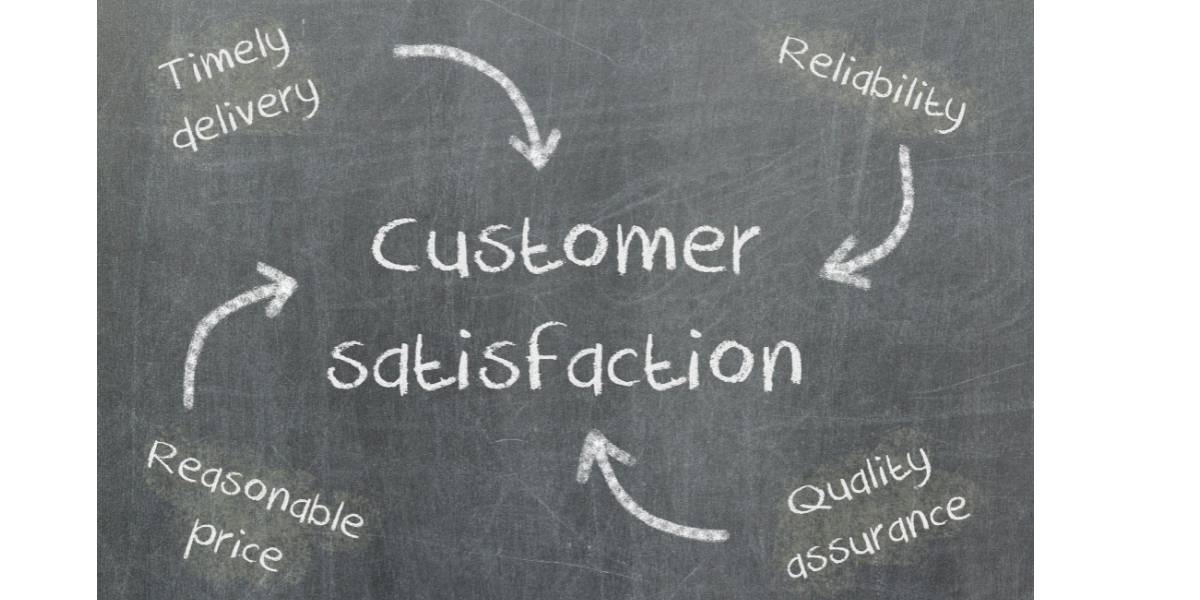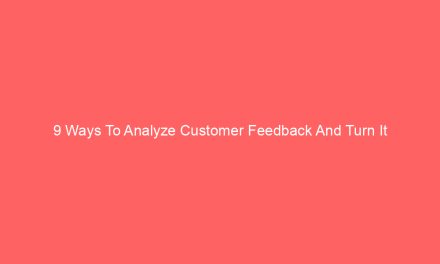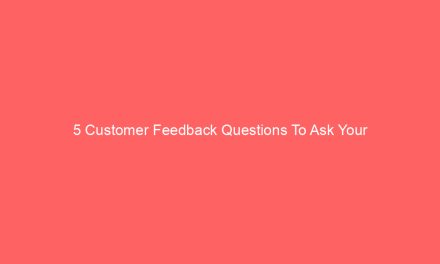Mastering Customer Reach Strategies: A Comprehensive Guide
Introduction
Mastering customer reach strategies is a key determinant of business success. In this comprehensive guide, we will explore the essential steps to connect with your audience effectively. By the end of this article, you will have the knowledge and tools to boost your customer reach and grow your business.
Understanding the Significance of Customer Reach
Before we delve into the strategies for mastering customer reach, it’s essential to grasp the profound significance of this concept. Customer reach is more than just a metric; it’s the lifeblood of your business’s growth and sustainability.
Imagine your customer reach as a vast net that extends far and wide, casting itself over a wide-ranging audience. This expansive reach is akin to turning on a beacon that illuminates your brand and offerings to potential customers. The implications are profound.
- Increased Sales Potential: When your business has a broad customer reach, it naturally follows that more eyes and ears are tuned in to what you have to offer. The more people who are aware of your products or services, the greater the potential for sales. A wide customer reach is like opening multiple doors to potential buyers, increasing the likelihood of conversions and revenue growth.
- Enhanced Brand Recognition: Brand recognition is a cornerstone of trust and credibility in the business world. When your business is visible to a wide audience, it’s like etching your brand’s name into the collective memory of your target market. This recognition builds trust and confidence, making consumers more likely to choose your brand when making purchasing decisions.
- Competitive Edge: In a crowded marketplace, standing out is crucial. An extensive customer reach allows your business to stay ahead of the competition. Your brand becomes synonymous with your industry, setting you apart as a leader, and attracting customers who are looking for the very solutions you provide.
- Adaptability and Growth: A broad customer reach doesn’t just mean more customers; it means a larger pool of data and feedback to work with. The insights gathered from this expanded reach enable your business to adapt to changing market trends and customer needs. This adaptability is key to sustained growth in an ever-evolving business landscape.
Setting Clear Objectives
Define your goals clearly. Do you want to increase brand awareness, generate leads, or boost sales? Setting specific objectives will guide your strategy.
When it comes to mastering customer reach strategies, one of the critical foundational steps is setting clear and well-defined objectives. Think of this as the compass that guides your journey in connecting with and engaging your target audience.
- Defining Your Path: Setting clear objectives is akin to defining the path you want to take. It’s the answer to the question of where you want your business to be in terms of customer reach. Do you aim to increase brand awareness, generate leads, or boost sales? Each of these objectives represents a different path, and knowing which one to take is paramount.
- Precision in Strategy: Your objectives shape your strategy. When your goals are clearly defined, you can craft a strategy that aligns perfectly with them. For example, if your primary objective is to increase brand awareness, your strategy will involve content and campaigns geared towards making your brand more visible. On the other hand, if you want to generate leads, your approach might revolve around capturing customer information and nurturing them towards a purchase.
- Measuring Progress: Clear objectives provide benchmarks for measuring progress. They act as the yardstick against which you can gauge your success. If you’ve set a specific sales target, you can measure your performance against it regularly. This not only helps you stay on track but also provides early warning signs if your efforts are falling short of your goals.
- Team Alignment: In any business, reaching customers is often a collaborative effort. Clear objectives are the glue that binds your team together. When everyone knows what you’re working towards, they can align their efforts accordingly. It ensures that your entire team is moving in unison towards the common goal.
- Resource Allocation: Your resources, whether it’s time, budget, or personnel, are limited. Setting clear objectives helps you allocate these resources effectively. You can ensure that you’re directing your investments where they will have the most impact. This not only avoids resource wastage but also optimizes your returns.
Identifying Your Target Audience
Knowing your target audience is essential. Conduct thorough research to understand their needs, preferences, and pain points. This insight will help tailor your approach.
When it comes to mastering customer reach strategies, one of the pivotal steps is identifying your target audience. This process involves delving deep into understanding who your potential customers are, what they need, what they like, and what challenges they face. This insight forms the cornerstone of effective customer reach strategies. Here’s why it’s so essential:
- Laser-Focused Approach: Knowing your target audience allows you to adopt a laser-focused approach to your marketing and outreach efforts. Instead of casting a wide net, you can direct your resources and messaging precisely where they will have the most impact. It’s like having a treasure map that guides you to the gold.
- Tailoring Your Message: Every audience is unique, and their needs and preferences can vary significantly. By conducting thorough research, you gain the insight needed to tailor your message. This means you can speak directly to the pain points, desires, and aspirations of your potential customers, making your marketing more effective.
- Problem Solving: Effective marketing and customer reach often involve problem-solving. By understanding your audience’s pain points and challenges, you can position your products or services as solutions. It’s not just about what you offer but how you can make your audience’s lives better.
- Building Trust: Trust is a cornerstone of successful customer relationships. When you show that you understand your audience’s needs and cater to them, you build trust. Customers are more likely to choose a brand they trust over a competitor, making this a critical step in building lasting relationships.
- Efficient Resource Allocation: Marketing resources, such as budget and time, are limited. Knowing your target audience helps you allocate these resources more efficiently. You can focus your efforts on the channels and strategies that are most likely to resonate with your audience.
- Market Differentiation: In a competitive market, understanding your audience can be a key differentiator. It’s the way you stand out from the crowd. When you speak directly to the needs and desires of your audience, you become the go-to solution in their eyes.
Crafting a Persuasive Value Proposition
Your value proposition should stand out. It’s what differentiates you from competitors. Create a compelling message that clearly communicates the value you offer.
- The Art of Differentiation: In a crowded marketplace, customers are inundated with choices. What sets your business apart from the rest? Your value proposition is the answer to this question. It’s your unique selling point (USP) that highlights what makes you different, why you’re special, and why customers should choose you over others.
- Clear Communication: Your value proposition is your chance to communicate your value clearly and concisely. It should articulate what you do, who you do it for, and why it matters. Think of it as your elevator pitch—a brief, persuasive summary of your brand’s essence.
- Customer-Centric Focus: Crafting a persuasive value proposition is not about what you want to say but about what your customers want to hear. It’s about addressing their pain points, needs, and desires. When your value proposition resonates with your target audience, it creates a powerful connection.
- Trust and Credibility: A well-crafted value proposition builds trust and credibility. When you communicate your unique value clearly and consistently, customers perceive you as reliable and professional. It gives them the confidence to choose your brand.
- Competitive Edge: In a sea of similar offerings, your value proposition is your lifeboat. It’s what keeps you afloat and moving ahead of competitors. It becomes your beacon of light that guides customers to you, even in the stormiest of markets.
- Motivation for Action: An effective value proposition not only communicates what you offer but also why it’s beneficial. It motivates potential customers to take action, whether it’s making a purchase, signing up, or engaging with your brand. It highlights the value and the benefits they’ll gain.
- Consistency Across Channels: Your value proposition should be a consistent thread woven throughout all your marketing efforts, from your website to your social media to your advertisements. This coherence reinforces your message and makes it memorable.
Leveraging Digital Marketing Channels
In the digital age, the scope and impact of marketing have undergone a transformative evolution. Traditional approaches are making way for dynamic, data-driven strategies that allow businesses to reach a broader and more engaged audience. This process is often referred to as “digital marketing,” and it’s a powerful tool for connecting with your target audience. Let’s dive into the essential aspects of leveraging digital marketing channels:
- A Multifaceted Approach: Digital marketing is not a one-size-fits-all solution. It’s a multifaceted approach that involves the strategic use of various online channels to promote and market your business. By exploring a variety of digital marketing channels, you can engage with a diverse range of potential customers.
- Pay-Per-Click Advertising (PPC): PPC advertising is a versatile method that allows you to display your ads on platforms like Google, Bing, or social media sites. What sets PPC apart is its pay-as-you-go model, where you pay only when a user clicks on your ad. This cost-effective approach helps businesses target specific demographics and keywords, ensuring that your message reaches a relevant audience.
- Social Media Marketing: Social media platforms like Facebook, Instagram, Twitter, and LinkedIn have become powerful marketing tools. With billions of users worldwide, they offer an immense opportunity to engage with potential customers. Each platform has its unique strengths and demographics, allowing you to tailor your approach to the audience you want to reach.
- Content Marketing: Content is at the core of digital marketing. It includes blog posts, articles, videos, infographics, and more. Creating valuable, informative, and engaging content not only attracts your target audience but also positions your business as an authority in your industry. Content marketing is a long-term strategy that builds trust and fosters customer loyalty.
- Search Engine Optimization (SEO): SEO is the art and science of optimizing your website’s content to rank higher in search engine results. When your website appears at the top of search results, it gains more visibility and credibility. Effective SEO helps potential customers find your business when they search for relevant keywords.
- Email Marketing: Email marketing remains a tried-and-true digital channel. It allows you to nurture leads, engage with customers, and provide value directly to their inbox. Personalized and relevant email campaigns can drive conversions and build lasting relationships with your audience.
- Analytics and Data-Driven Insights: One of the key advantages of digital marketing is the ability to gather data and insights. With tools like Google Analytics, you can track the performance of your campaigns, measure the success of your strategies, and make data-driven decisions to optimize your approach.
The Power of Social Media Engagement
Social media is a goldmine for customer reach. Actively engage with your audience on platforms like Facebook, Instagram, and X (formally Twitter) to create a loyal following.
- A Dynamic Connection Hub: Social media platforms are bustling hubs of activity, where people from around the world connect, share, and interact. As a business, these platforms offer you a direct line to your potential customers. Engaging with your audience here allows you to become a part of their online social sphere.
- Two-Way Communication: Unlike traditional advertising, social media fosters two-way communication. It’s not just about broadcasting your message but also about listening and responding. Engaging with your audience demonstrates that you value their opinions and are responsive to their needs, which builds trust and loyalty.
- Building a Loyal Following: Actively engaging with your audience on social media is the cornerstone of building a loyal following. When your interactions are genuine, helpful, and consistent, you create a community of customers who feel a personal connection to your brand. This connection goes beyond transactions; it’s about building relationships.
- Content Virality: Social media is the breeding ground for content virality. Engaging content, whether in the form of entertaining videos, informative blog posts, or visually appealing images, has the potential to go viral. When your audience engages with and shares your content, your reach expands exponentially.
- Real-Time Insights: Social media provides real-time insights into your audience’s thoughts, preferences, and trends. These insights can be used to fine-tune your strategies, refine your product offerings, and stay ahead of the curve in your industry.
- Promoting User-Generated Content: User-generated content, when shared and celebrated, can become a powerful tool in your marketing arsenal. Encourage your customers to create content related to your brand, and then engage with and share this content on your social media. It not only reinforces your message but also highlights the positive experiences of your customers.
- Customer Service and Support: Social media is a customer service and support channel in its own right. Responding promptly to inquiries and resolving issues on these platforms demonstrates your commitment to customer satisfaction. It’s a transparent way to address concerns and showcase your dedication to customer care.
Creating High-Quality Content
Content is king. Develop informative, engaging, and shareable content that resonates with your target audience.
- Informative and Educational: High-quality content is a source of information and education. It doesn’t just market your product or service; it provides value by answering questions, solving problems, and offering insights. It positions your brand as a knowledgeable authority in your industry.
- Engagement and Interactivity: Exceptional content goes beyond just words on a page. It engages your audience, sparking discussions, and encouraging interactions. Whether it’s through blog comments, social media shares, or interactive multimedia, your content should be a two-way street.
- Resonance and Relevance: The best content is the kind that resonates with your target audience. It speaks their language, addresses their concerns, and is tailored to their interests. This relevance ensures that your message is not just seen but also heard.
- Shareability: High-quality content is shareable content. When your audience finds value in what you’ve created, they’re more likely to share it with their networks. This word-of-mouth marketing extends your reach organically, introducing your brand to new potential customers.
- Credibility and Trust: Well-researched and well-written content builds credibility and trust. When your audience can rely on your content to be accurate, insightful, and unbiased, it not only enhances your reputation but also fosters long-term customer relationships.
- Optimized for Search: High-quality content doesn’t just cater to your audience; it’s also optimized for search engines. Effective use of keywords, headings, and meta descriptions helps your content rank higher in search results, increasing its visibility.
- Variety and Creativity: Exceptional content doesn’t rely on a single format. It’s diverse and creative, encompassing blog posts, videos, infographics, podcasts, and more. This variety caters to different preferences and learning styles, ensuring your message reaches a broader audience.
- Consistency: Consistency is a hallmark of high-quality content. Your audience should know what to expect from your brand. Regular posting schedules and a consistent tone and style create a sense of reliability and reliability.
Email Marketing: A Tried and True Method
One method has stood the test of time and remains as effective as ever – email marketing. Building and nurturing an email list is not just a strategy; it’s a tried and true method that enables you to connect with your audience, provide value, and convert customers. Let’s explore why email marketing remains a cornerstone of customer reach strategies:
- Direct Communication: Email marketing provides a direct and personal channel of communication with your audience. Unlike social media or search engines, your email list is a captive audience that has expressed interest in your brand. This direct line of communication allows for one-on-one conversations with your potential customers.
- Nurturing Leads: Effective email marketing is all about lead nurturing. It’s the process of guiding potential customers through the sales funnel, from initial awareness to making a purchase decision. Through a series of well-crafted emails, you can educate, inform, and build trust with your leads, increasing the likelihood of conversion.
- Providing Value: Email marketing isn’t just about promoting products or services; it’s about providing value to your audience. By sharing valuable content, such as informative articles, how-to guides, tips, and special offers, you keep your subscribers engaged and interested. This value-driven approach reinforces their connection with your brand.
- Segmentation and Personalization: Modern email marketing tools allow for segmentation and personalization. You can tailor your emails to specific segments of your audience, ensuring that the content is highly relevant to their interests and needs. Personalized emails lead to higher engagement and conversion rates.
- Automated Campaigns: Email marketing enables you to set up automated campaigns. This means that once you’ve designed your email sequence, it can run automatically, nurturing leads and converting customers while you focus on other aspects of your business.
- Measurable Results: Email marketing provides measurable results. You can track open rates, click-through rates, conversion rates, and more. These insights allow you to refine your strategies, optimize your content, and understand what works best for your audience.
- Cost-Effective: Compared to many other marketing strategies, email marketing is cost-effective. It doesn’t require a massive advertising budget. Instead, it relies on your ability to create compelling content and a dedicated email list.
- Long-Term Relationships: Building a loyal customer base is a long-term endeavor, and email marketing is a perfect tool for nurturing these long-term relationships. It’s not just about the initial sale but about creating customers who come back and become brand advocates.
Search Engine Optimization (SEO)
Optimizing your website for search engines is nothing short of essential. Search Engine Optimization, commonly known as SEO, is the practice of fine-tuning your online presence to help your business rank higher in search results, ultimately driving organic and highly valuable web traffic. Let’s delve into why SEO is a cornerstone of effective customer reach strategies:
- Improved Visibility: Search engines, like Google, serve as the primary gateway to the vast online world. When you optimize your website, it becomes more visible to users who are actively searching for products, services, or information related to your business. SEO is the process of ensuring that your site appears prominently in these search results, enhancing your online visibility.
- Higher Ranking: SEO isn’t just about getting your website on the first page of search results; it’s about securing a higher ranking within that page. Studies have shown that the vast majority of clicks go to the top results, so securing a top spot can significantly boost your web traffic.
- Trust and Credibility: Websites that appear at the top of search results are often perceived as more trustworthy and credible by users. SEO helps your business build authority in your industry, positioning you as a go-to source of information or products.
- Cost-Effective Marketing: Organic traffic generated through SEO is cost-effective. Unlike paid advertising, where you pay for each click, SEO efforts can provide long-term benefits without ongoing advertising costs. It’s like owning a prime piece of digital real estate.
- Targeted Audience: SEO allows you to reach a highly targeted audience. When you optimize your site for specific keywords or phrases, you attract users who are actively interested in what you have to offer. This audience is more likely to convert into customers.
- User Experience: SEO isn’t just about keywords; it’s also about providing a better user experience. A well-optimized site is not only easier for search engines to crawl and index but is also more user-friendly. This results in lower bounce rates and higher user engagement.
- Adaptation to Trends: SEO is a dynamic field that adapts to the changing algorithms and user behavior. By staying updated with SEO trends, you can remain competitive in the digital landscape and ensure that your site continues to rank well.
- Local SEO: For brick-and-mortar businesses, local SEO is vital. It ensures that your business appears in local searches, driving foot traffic and phone inquiries. It’s like a roadmap for local customers to find your business.
Influencer Marketing
Influencer marketing has emerged as a potent strategy that enables businesses to harness the reach and credibility of influential figures in their industry. By collaborating with these influencers, you can significantly expand your customer reach and establish greater credibility. Let’s explore why influencer marketing is a game-changer for customer reach strategies:
- Leveraging Trust: Influencers have built trust and rapport with their followers over time. Their endorsements are viewed as genuine and unbiased. When an influencer speaks positively about your product or service, their audience is more likely to trust and engage with your brand.
- Expanded Reach: One of the primary advantages of influencer marketing is the ability to tap into a broader audience. Influencers often have a substantial and dedicated following. Collaborating with them allows your brand to reach a vast number of potential customers that you might not have access to otherwise.
- Targeted Promotion: Influencers are experts in crafting content that resonates with their audience. By choosing the right influencers in your niche, you can ensure that your message reaches the most relevant and interested potential customers.
- Credibility and Authority: When an influencer endorses your product or service, it’s not just about exposure; it’s also about borrowing their credibility and authority. This association can elevate your brand in the eyes of their followers, positioning you as a trustworthy and reliable choice.
- Engagement and Interaction: Influencer marketing isn’t just about passive exposure; it’s about generating active engagement. Influencers often spark discussions, Q&A sessions, and direct interactions with their followers, providing an excellent opportunity for real-time engagement with potential customers.
- Diverse Content Formats: Influencers create a wide variety of content, from blogs and videos to social media posts and podcasts. This versatility allows you to tailor your message to different audience preferences and platforms.
- Content Amplification: Influencer content has the potential to go viral. When an influencer shares their positive experiences with your brand, their followers often share it further, amplifying the reach of your message organically.
- Long-Term Relationships: Building long-term relationships with influencers can lead to sustained benefits. By nurturing ongoing collaborations, you can continuously tap into their audience and evolve your strategies to meet changing market dynamics.
Analyzing and Measuring Success
The ability to analyze and measure the success of your efforts is indispensable. Data analytics is your compass, helping you navigate the digital landscape and make informed decisions to continually improve your reach. Let’s delve into why analyzing and measuring success are vital components of your strategy:
- Quantifiable Insights: Data analytics provides quantifiable insights into the performance of your strategies. You can measure key performance indicators (KPIs) such as website traffic, conversion rates, click-through rates, and more. These insights reveal what’s working and what needs improvement.
- Data-Driven Decision Making: Rather than relying on intuition or guesswork, data analytics empowers you to make data-driven decisions. It allows you to adjust your approach based on concrete evidence, optimizing your strategies for better results.
- Real-Time Monitoring: Digital marketing is dynamic, with trends and user behavior constantly evolving. Data analytics provides real-time monitoring, enabling you to adapt to changes swiftly. You can capitalize on emerging opportunities and respond to challenges in a timely manner.
- A/B Testing and Experimentation: Data analytics supports A/B testing and experimentation. You can compare the performance of different strategies, content, or campaigns to identify the most effective approaches. This iterative process drives continuous improvement.
- ROI Evaluation: Understanding the return on investment (ROI) is crucial. Data analytics helps you evaluate the financial impact of your efforts. It enables you to determine which strategies are delivering the best results for your investment.
- User Behavior Insights: By tracking user behavior on your website and other digital platforms, you gain valuable insights into what your audience prefers and responds to. This information guides content creation and strategy adjustments.
- Segmentation: Data analytics allows for audience segmentation. You can categorize your audience based on various criteria, such as demographics, location, and behavior. This segmentation helps in tailoring your strategies to different customer segments.
- Identifying Weaknesses: Through data analysis, you can pinpoint weaknesses or bottlenecks in your customer reach process. This information is essential for making adjustments and removing obstacles that hinder your reach.
- Feedback Loop: Data analytics creates a feedback loop where you continually analyze results, make improvements, and reassess. This iterative process is the foundation of ongoing optimization and success.
The Role of Customer Feedback
Customer feedback plays an invaluable and transformative role. It’s not just data; it’s a powerful tool for improvement and a means of showing your audience that their opinions matter. Let’s explore why customer feedback is a cornerstone of effective strategies for reaching and engaging your audience:
- Valuable Insights: Customer feedback provides valuable insights into how your audience perceives your products, services, and brand. It’s a window into their experiences and expectations, helping you better understand their needs and preferences.
- Quality Improvement: Feedback is a catalyst for quality improvement. When customers share their experiences, both positive and negative, it highlights areas where your business can excel and where it needs to make adjustments. It’s a roadmap to enhancing the quality of your offerings.
- Enhanced Customer Experience: By actively listening to customer feedback, you can tailor your strategies to create a more personalized and positive customer experience. Addressing concerns and implementing suggestions can lead to happier and more loyal customers.
- Trust and Loyalty: Customer feedback fosters trust and loyalty. When customers see that their opinions are taken seriously and result in tangible improvements, it builds confidence in your brand. This trust often translates into long-term loyalty.
- Product Development: Feedback is a goldmine for product development. It can inspire new product ideas or improvements to existing ones. By involving your customers in the development process, you create products that better meet their needs.
- Transparency and Communication: Openly soliciting and acting on customer feedback demonstrates transparency and effective communication. It shows that your brand values its customers and is committed to meeting their expectations.
- Effective Marketing: Customer testimonials and positive feedback can be powerful marketing tools. They serve as social proof, influencing potential customers by showcasing the positive experiences of others.
- Competitive Advantage: In a competitive market, the ability to actively use customer feedback for improvement can set your brand apart. It’s a distinguishing factor that shows your commitment to excellence.
- Feedback Loop: Customer feedback creates a feedback loop where insights lead to improvements, and improvements lead to more feedback. This continuous cycle of listening, adapting, and communicating is essential for ongoing success.
Building Long-Term Customer Relationships
Long-term customer relationships are built on trust and excellent service. Focus on retaining your existing customers. The ability to build and nurture long-term customer relationships stands as a hallmark of success. These relationships are not forged overnight but are the result of trust, excellent service, and a deep commitment to retaining your existing customers. Let’s explore why building long-term customer relationships is a fundamental aspect of effective customer reach strategies:
- Trust and Credibility: Long-term customer relationships are built on a foundation of trust and credibility. When customers trust your brand and believe in the quality of your products or services, they are more likely to stay loyal.
- Customer Loyalty: Loyal customers are the lifeblood of any business. They not only make repeat purchases but often become advocates for your brand, spreading positive word-of-mouth and referrals.
- Predictable Revenue: Long-term customers provide a predictable source of revenue. Unlike one-time transactions, they contribute to the steady growth and sustainability of your business.
- Cost Savings: It’s often more cost-effective to retain existing customers than acquire new ones. Building relationships with your current customer base can result in significant cost savings over time.
- Personalization: As you build long-term relationships, you can personalize your interactions and offerings. This tailored approach demonstrates that you understand and value your customers’ unique needs and preferences.
- Feedback and Improvement: Long-term customers provide valuable feedback that can drive improvements. By actively listening to their suggestions and concerns, you can refine your products and services, further enhancing the customer experience.
- Brand Advocacy: Satisfied long-term customers are more likely to become brand advocates. They can champion your brand on social media, in reviews, and through referrals, effectively extending your reach.
- Customer Lifetime Value (CLV): Building long-term relationships increases the customer lifetime value (CLV). This metric reflects the total revenue a customer is expected to generate throughout their relationship with your brand.
- Retention Strategies: Focusing on long-term relationships allows you to develop specific retention strategies. These strategies can include loyalty programs, exclusive offers, and ongoing communication to keep customers engaged.
- Reputation Management: Happy, long-term customers contribute to a positive brand reputation. Reputation management is vital in today’s digital age, where a single negative review can have a significant impact.
Conclusion
Mastering customer reach strategies is a dynamic process. It requires consistent effort and adaptation to changing trends. By following the steps outlined in this guide, you will be well on your way to increasing your customer reach and achieving sustainable business growth.
Frequently Asked Questions
1. What is the significance of customer reach in business?
Customer reach is vital for business success as it determines the extent to which your brand is visible to potential customers, impacting sales and brand recognition.
2. How can I identify my target audience effectively?
Identifying your target audience involves thorough research to understand their needs, preferences, and pain points. This knowledge helps tailor your approach.
3. What is the role of influencer marketing in customer reach?
Influencer marketing can expand your customer reach and credibility by leveraging the popularity and trust influencers have with their followers.
4. How do I measure the success of my customer reach strategies?
Use data analytics to measure the success of your strategies, and make necessary adjustments based on insights to continually improve your reach.
5. Why is building long-term customer relationships important?
Building long-term customer relationships is essential for business sustainability. It’s based on trust and excellent service, leading to customer loyalty and repeat business.










